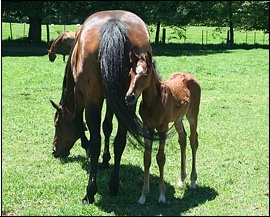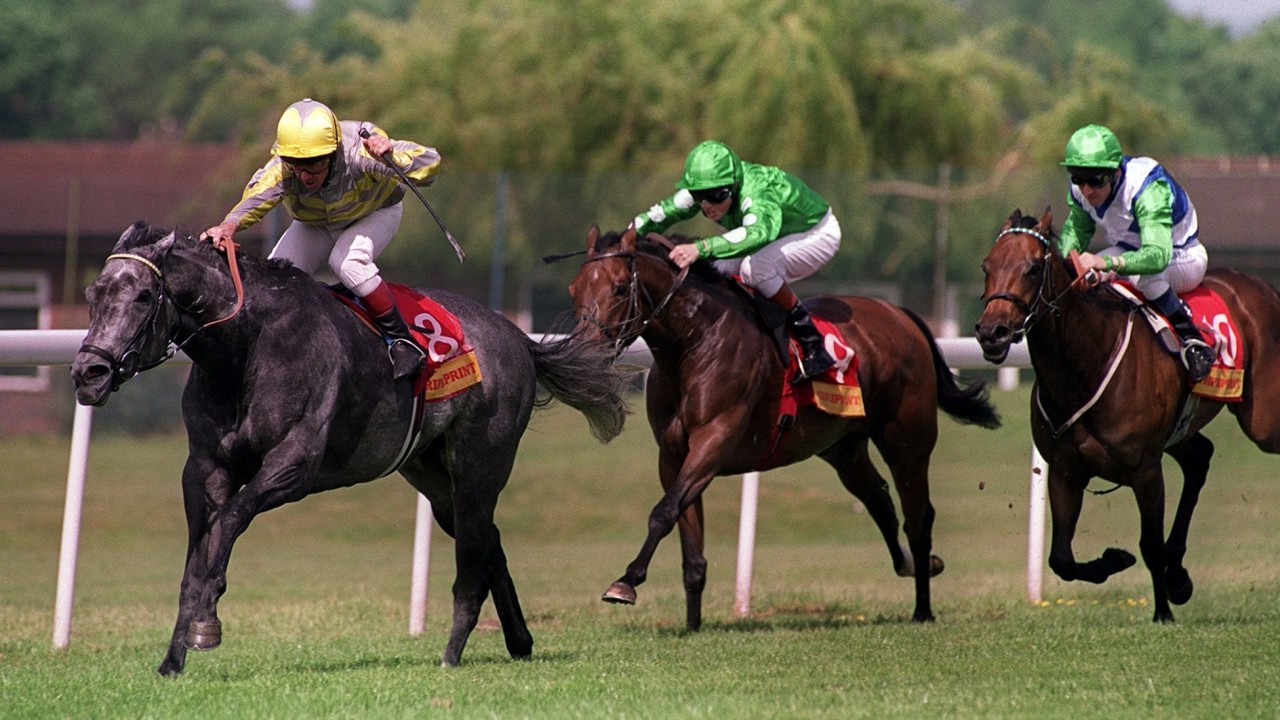Mare Breeding Season Information – Veterinary Perspective
| Mare Breeding Season Information – Veterinary Perspective |
 Dr Alan Bechard of Almiray Farm provides a brief summary of the vast subject of what goes into breeding a mare, and to produce a viable foal. The aim of this communication is to provide mare owners with some information as to what happens to the mares in season and what normal expectations may be.
Dr Alan Bechard of Almiray Farm provides a brief summary of the vast subject of what goes into breeding a mare, and to produce a viable foal. The aim of this communication is to provide mare owners with some information as to what happens to the mares in season and what normal expectations may be.
Our goal as stud vets is to have as many mares in foal, as early in the season as possible, and the once the mares are in foal to maintain their pregnancies and to produce a viable foal.
Early conceptions and thus early foals are important. We know bigger, more mature yearlings are easier to get on sales and command a better sales price. Mares are generally in foal between 335 and 342 days, (+- 11 months), so not much time is available to get the mare to re-concieve if a foal is to be produced every year.
Mares are seasonally polyoestrus, which means they usually do not cycle in winter and as summer comes along they will begin to cycle. A mare is usually in season for 4-6 days and will show a season every 3 weeks. The stimulus to cycle is increasing day length, warmth and adequate nutrition. The authority that controls the industry, the National Horseracing Authority, has stipulated that we can begin breeding mares from 1 September. The problem we have is that not many mares will by cycling by the first of September as it’s too early for them to have responded. We can increase the number of mares cycling by that date by artificially increasing day length, (by placing mares under lights), making sure the nutrition is good and by the use of certain hormones. Unfortunately, when our breeding season is ending, (usually mid-December), the mares are at their most fertile and cycling normally, naturally.
Barren and maiden mares will be teased, (presented to a stallion and their response observed), usually from the beginning of August and brood mare managers will record which mares show normal activity and which mares do not. The mares that do not show normal cycling activity will be presented to the vet for evaluation. According to the findings of the examination, advice will be given as to what the mare needs to help her cycle. Barren and maiden mares will be teased and monitored by ultrasound scanning when required and should all go well, the mare will be in season in early September. The best date for cover will be determined by the ultrasound information and the mare will then be covered. Our aim is to cover a mare once per cycle although a mare may need more than one cover per cycle.
An ovulatory induction hormone is usually used at the time of cover and the mare will be scanned again two or three days after cover to ensure ovulation has taken place. If an abnormalities are detected at this stage, the mare will be treated accordingly.
The mares are scanned again at 14 or 15 days after ovulation to establish whether conception has taken place or not. Should the mare not be in foal, the process begins again. Should the mare be in foal, the size and location of the pregnancy is described as well as whether there are twins or not. Twins in mares are not sort after, because a mare carrying twins usually aborts them at approximately seven months gestation. There is just not enough space in the mare for her to produce two viable foals. Thus steps are taken, as soon as suitable to eliminate a twin, and maintain one. In foal mares will be scanned again at 30 days and again at 45 days. These scans are to monitor the pregnancy and viability thereof and to initiate any therapy the mare may need to maintain her pregnancy. Foaling mares are brought into the foaling boxes before their due date. This enables them to adapt to a new routine. They are monitored 24 hours a day and most mares will foal at night. During the foaling process, the mare is closely monitored by the foaling team and should she not progress normally, veterinary assistance is called for. Fortunately, most mares foal down naturally, although occasionally complications do occur. There are standard processes and procedures which take place at foaling and immediately after foaling to ensure the new born foal gets the best possible start. The new born foal has an immature immune system and its critical the foal gets adequate levels of passive immunity from the initial milk or colostrum. Samples are taken of the colostrum to measure quality. Samples are also taken from the foal the day after it is born to confirm it has absorbed adequate levels of immunity from the colostrum. Foaling mares will usually have their first cycle approximately 10 days after foaling.
This is called a foal heat and is usually not used to cover the mare on. This is because the conception rates and resorbtion rates of mares covered on foal heats is lower than later heats. Foal heats are often used late in the season when time is running out. Generally we try to get the mares covered on the heat following the foal heat and this is usually a month after foaling. The process from here on is as described for the barren and maiden mares. Not all mares follow a normal pattern. Some will not cycle as they should, some will cycle but will not tease to a stallion, some will show irregular cycles, some will not cycle with a foal at foot and some wont cycle at all. The selection process for breeding mares is usually race performance and genetics, and historically has not been fertility, and we are sometimes trying to breed a mare that may not be optimally fertile.
The brood mare manager and vet will decide on procedures for each mare to increase her chances of conception. There are certain normal that we can expect and these normal’s are without any major disease outbreaks affecting the health of mares or stallions. The end of season conception rate is usually between 80 to 90% in foal at the end of the season. The losses between conception, i.e. the initial check at 14 days and foaling is 12%. The reproductive performance is strongly correlated to the average mares age. Once mares pass 15 or 16, they are generally more difficult to get in foal and the losses between conception and foaling are greater.
The mares are scanned in specific holding area or crush. The crush is designed specifically with the mares safety, personnel and equipment safety in mind. Most mares cope well and are compliant with the procedure, but some may need chemical or physical restraining. Mares are bought into the crush, the rectal canal evacuated and the reproductive organs then evaluated with an ultrasound. The process of scanning provides essential information that is required. It tells s whether the mare is cycling or not, when she needs to be covered, when she has ovulated, whether she needs any treatment, where she is in foal, whether the foetus is viable and growing normally.
The scanning process is not without some risk. The rectal lining is thin and if damaged or perforated, may be life threatening. All due care is thus taken to ensure no damage occurs. The risks are greater with maiden mares as they are not used to the procedure. Particular care is thus taken with maiden mares.


